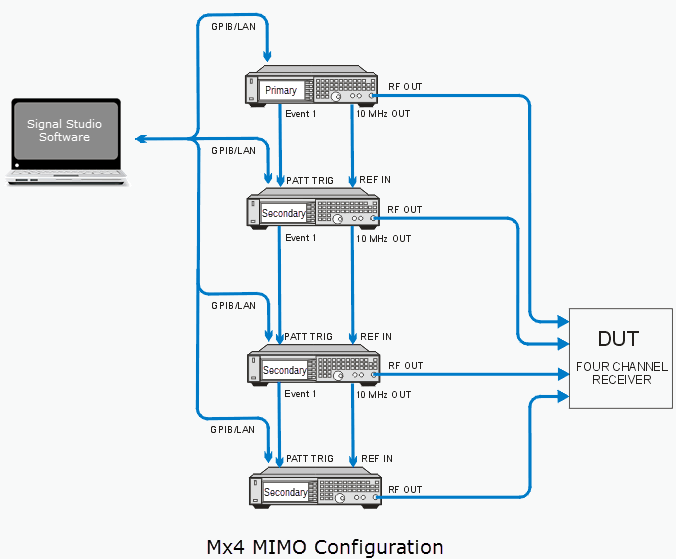MIMO Setup with Baseband Timing Alignment without RF Phase Coherence
The figure below shows you how to configure four signal generators (N5182A MXG, N5172B EXG, or N5182B MXG) as multiple antennas with baseband timing alignment, but without RF phase coherence.
You can use multiple N5182A MXG signal generators in the same system, or you can use multiple N5172B/N5182B signal generators in the same system. However, to use a mixture of N5182A and N5172B/N5182B signal generators in the same system, you must assign an N5172B/N5182B as the primary and any N5182A secondaries must be positioned at the end of the instrument chain.

The X-Series signal generator (N5172B/N5182B) provides precise baseband timing alignment as a standard feature, which synchronizes the start of the BBG waveform playback of up to 16 signal generators. For the N5182A, the playback is synchronized to within a characteristic value of ± 8 ns between the primary and the last secondary. For the N5172B or N5182B, the playback is synchronized to within a characteristic value of ± 5 ns between the primary and the last secondary. This minor amount of delay (± 8 ns or ± 5 ns) can be reduced further to picosecond resolution by adjusting the I/Q Delay. To reduce the delay, check and adjust the BBG signal alignment for each signal generator in the system. For more information on adjusting the delay, see ”I/Q Adjustments” in the MXG/EXG X-Series user's guide.
The delay value includes compensation for cables that have less than 1 ns of propagation delay between the EVENT 1 and PAT TRIG connectors. To minimize synchronization delay, the BNC cable 10502A is recommended for the rear-panel daisy chain connections.
The Event 1 connector on the primary MXG/EXG rear panel is connected to the Pattern Trigger In connector on the secondary MXG/EXG. This ensures that the two baseband generators are precisely synchronized at the start of the waveform playback. Synchronization occurs after the primary signal generator sends a one-time event pulse through the Event 1 connector to the secondary signal generator. Prior to this event, the secondary signal generator must recognize that it is waiting for this event pulse, which occurs during the system configuration (see "Multiple Baseband Generator Synchronization" in the MXG/EXG X-Series user's guide). In order to properly send the synchronization pulse, the Dual ARB Player for each signal generator must be turned off. The trigger source on both signal generators is automatically set by the software. On the primary MXG/EXG, it is set to "Bus" to wait for a SCPI command trigger through the GPIB or LAN bus. On the secondary MXG/EXG, it is set to "External" to receive a trigger through the rear-panel PAT TRIG connector.
When you start the Signal Studio software, you will need to choose a multiple-antenna configuration (M x 4 in this example) in the System Configuration Wizard. You will be asked for connection information for the corresponding number of MXG/EXG signal generators. The signal generators must have a valid license for advanced capability in order to have access to most of the software features for multiple antennas. Once you have connected to the MXG/EXG signal generators, the software will send the SCPI commands to the signal generators and will automatically finish the system configuration that is required by the synchronization process. This process is listed in "Multiple Baseband Generator Synchronization" in the MXG/EXG X-Series user's guide.
When you generate the waveforms for multiple antennas, the Signal Studio software pre-calculates the waveform packets and applies the effects of specific channels, then loads the composite waveform into each signal generator.